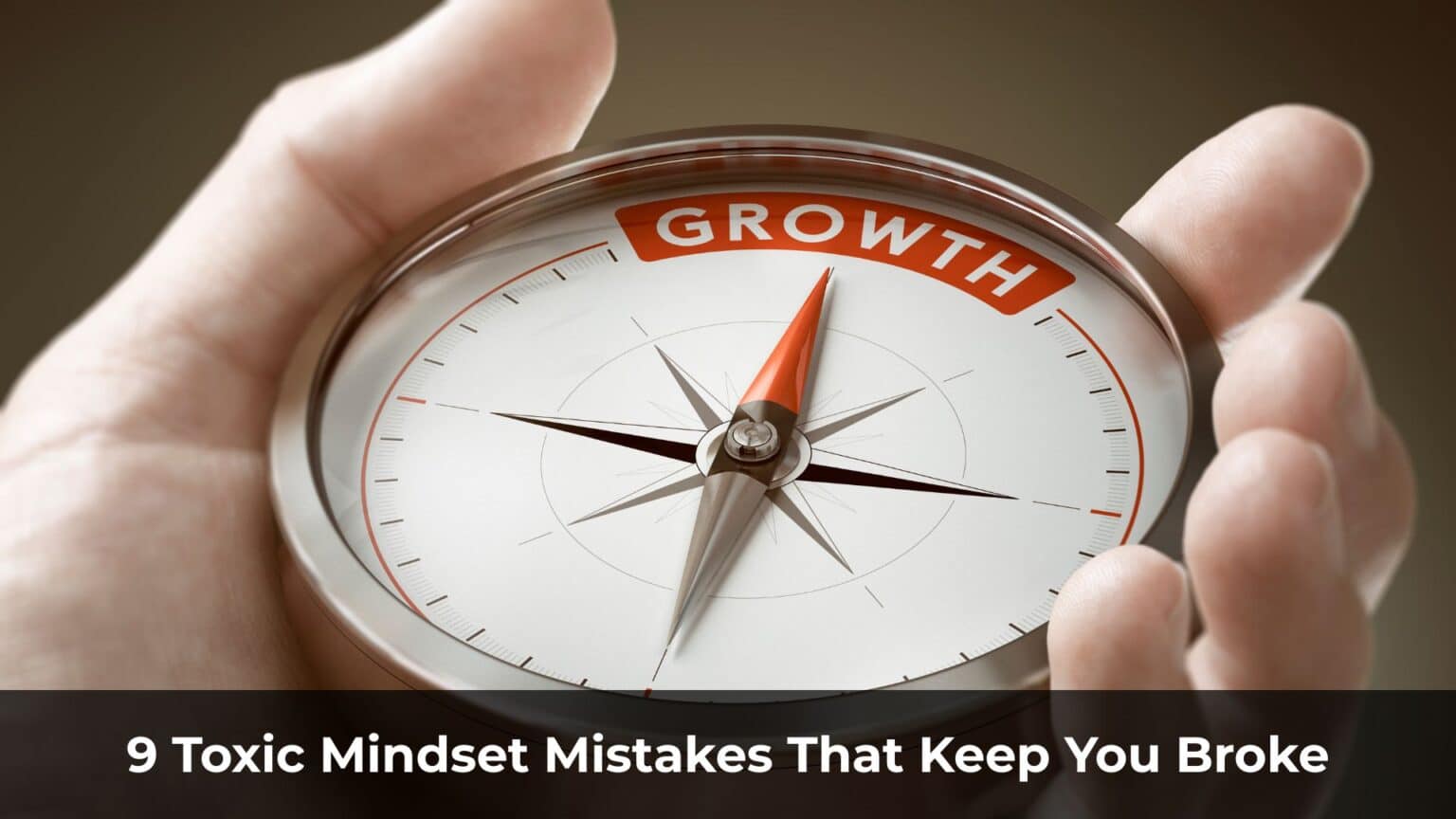Ever wondered what affiliate marketing will look like 10 years from now? With AI tools reshaping the landscape and platform policies changing weekly, it’s a question I hear constantly from my readers and coaching clients.
After weathering countless algorithm updates, platform shifts, and industry shakeups over the past decade, I’ve discovered something surprising: despite the constant change, certain core principles remain rock-solid.
That’s exactly why I’m writing this guide—to document the enduring principles that separate successful affiliate marketers from the perpetually struggling majority.
Today, I’ll share the 7 most crucial principles that have consistently generated results regardless of market conditions. These are the exact strategies I wish someone had taught me when I was burning through my first advertising budgets.
Table of Contents
ToggleMaster Market Timing: The Difference Between Profit and Pain
One of the costliest mistakes I see newcomers make is jumping into a market too late—when the “sharks” have already maximized exploitation and the market is declining.
Every affiliate campaign follows 4 distinct phases: Emergence, Growth, Saturation, and Decline.
How to identify each phase:
- Emergence: Few relevant ads on major channels, users respond with curiosity and positive engagement, abnormally high EPC (earnings per click)
- Growth: Ad volume increases but isn’t overwhelming, multiple affiliates begin sharing good results
- Saturation: Ads appear everywhere, landing pages look increasingly similar, advertising costs skyrocket
- Decline: Users develop “banner blindness” and respond negatively to ads, CTR plummets, conversion costs become unsustainable
I’ve watched countless beginners pour thousands into “dead” markets without realizing it. They see others still running ads and think, “there must still be money to be made here.”
Common reasons a niche dies:
- Market has been over-exploited
- Users have lost trust in the product/service category
- Better solutions have emerged in the marketplace
- Regulatory changes or platform policy shifts
Real-world examples I’ve tracked (2023-2025):
- AI Tools: Market exploded in late 2022 with ChatGPT, peaked mid-2023, but by 2024 was saturated with hundreds of similar tools competing for the same audience
- Social Media Enhancement Apps: Apps related to follower growth and engagement had their golden era in 2021-2022, but now show low ROI due to tightened platform policies
- Native Ads: After Facebook tightened policies, many affiliates switched to native ads, causing bid prices to surge from 2023, making many verticals non-viable by 2025
The key insight: Don’t chase trends already burning hot on affiliate forums. When everyone’s talking about it, you’re already a beat behind. Instead, look for emerging markets or fresh angles within existing markets.

Choose the Right Offer: Start With What Determines 80% of Results
After testing hundreds of offers across dozens of verticals, I’ve realized one fundamental truth: a good offer can succeed despite an ugly landing page, but a beautiful landing page can’t save a terrible offer.
Rather than testing 10 offers with drip-feed budgets (a common rookie mistake), focus on testing 2-3 offers with budgets large enough to gather statistically significant data.
What to test first:
- Offers with the highest EPC according to network reports
- Offers specifically recommended by your affiliate manager
- Offers with the highest payout in the same vertical
One common mistake is judging an offer’s effectiveness solely based on the offer page’s interface.
I’ve seen “ugly” pages that look like they were designed in 1999 consistently outperform sleek, modern designs. Why? Because conversion isn’t about aesthetics—it’s about addressing needs.
An unattractive page can convert surprisingly well when it:
- Addresses an urgent user need
- Features strong social proof (testimonials, reviews, case studies)
- Creates a sense of scarcity and urgency
- Offers high perceived value relative to price
Three strategies I’ve used to build advantage from offers:
- Test broadly → select winners
- Allocate 30% of your monthly budget to testing new offers
- Store test data systematically for analysis (I use a custom spreadsheet tracking 15 key metrics)
- Quickly scale offers showing promising signs within the first 100-200 clicks
- Negotiate exclusivity
- Propose exclusive conditions: specific geos, unique traffic sources
- Trade volume commitments for 20-30% higher payouts
- Request exclusive creative/angle testing opportunities
- Build relationships with advertisers for preferential treatment
- Communicate regularly, not just when problems arise
- Provide detailed feedback on lead/sale quality
- Suggest improvements for landing pages and payment processes
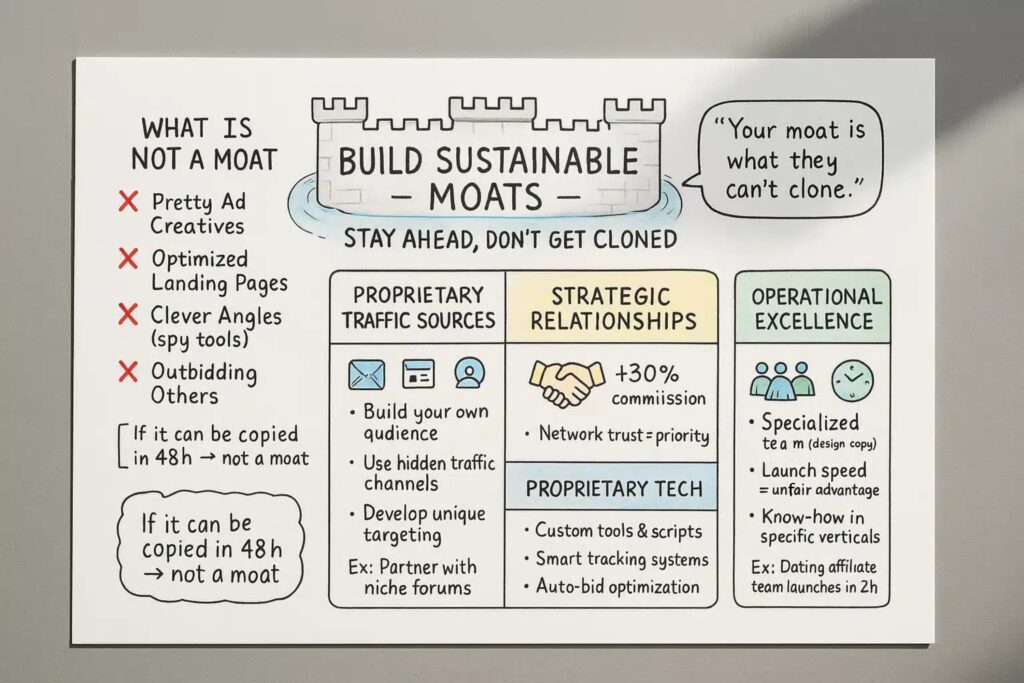
Build Sustainable Moats: Don’t Get Copied Then Left Behind
In affiliate marketing, success is often short-lived because everyone is ready to copy what works. I learned this painful lesson in 2019 when my highest-converting campaign was cloned within 48 hours of hitting profitability.
So how do you maintain a competitive advantage? You need to build what Warren Buffett calls a “moat”—a sustainable competitive advantage that competitors can’t easily replicate.
What is NOT a moat (don’t waste time here):
- Beautiful ad images and videos (easily copied)
- Conversion-optimized landing pages (can be cloned within hours)
- Clever angles (competitors will discover them through spy tools)
- Outbidding competitors (financially unsustainable)
Remember: If your advantage can be copied within 24-48 hours, it’s not a real moat.
4 types of battle-tested moats I’ve seen work consistently
1. Proprietary traffic sources
- Build your own audience (email list, retargeting pixel, messaging channel)
- Access traffic sources few people know about
- Develop unique targeting techniques that others can’t easily replicate
Example: Some of the smartest affiliates focus on niche health forums.
Instead of running paid ads, they negotiate directly with forum owners for premium placements—tapping into a highly engaged, specific audience that bigger players tend to overlook.
2. Strategic relationships with networks/advertisers
- Build deep relationships to get priority on hot offers
- Negotiate for commissions 20-30% higher than typical affiliates
- Get to test offers before official launch
3. Proprietary technology
- Develop custom tools to optimize campaigns
- Build advanced tracking/analytics systems
- Automate bid and budget optimization processes
4. Operational excellence
- Build specialized teams (designers, copywriters, developers)
- Establish efficient testing and optimization processes
- Develop exclusive know-how in specific verticals
Example: A top affiliate in the dating vertical has a team of 12 specialists, each responsible for a different aspect (research, creative, landing page, tracking…).
They can launch a new campaign in just 2 hours, while typical affiliates would take 1-2 days.
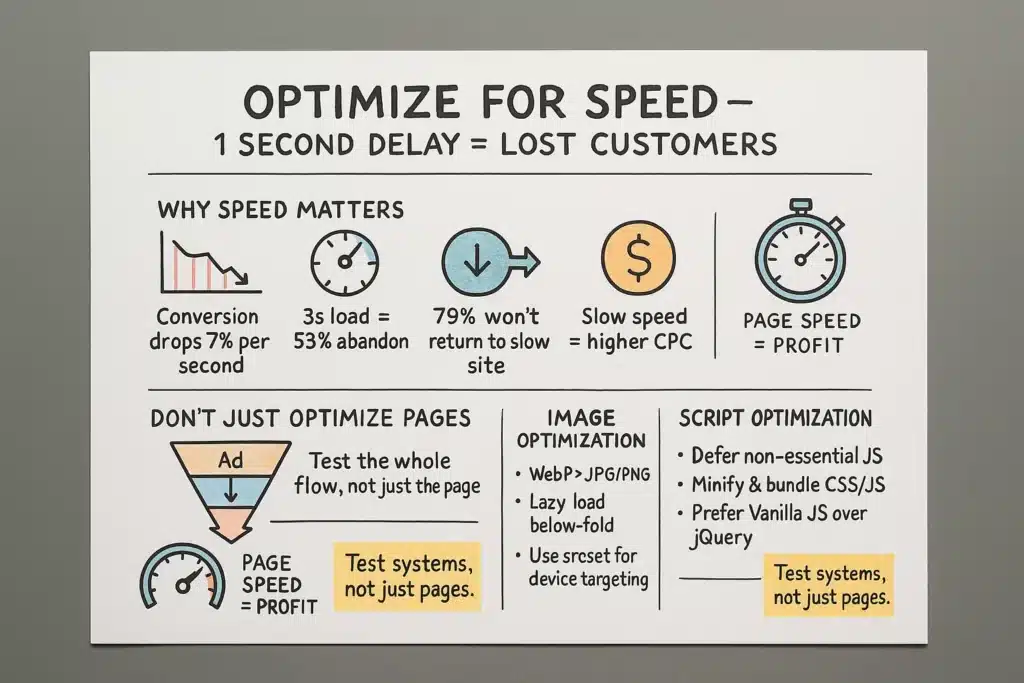
Optimize for Speed: Because 1 Second of Delay = Lost Customers
In an era where users have an attention span of just 8 seconds (down from 12 seconds a decade ago), speed isn’t optional—it’s survival.
User psychology & early exit patterns:
- 53% of mobile users will abandon a page that takes more than 3 seconds to load
- Each second of delay reduces conversion rates by 7%
- 79% of customers won’t return to a slow website
- Page load speed directly affects ad quality scores and CPC costs
Many affiliates focus solely on optimizing landing pages, forgetting that the entire conversion path (from ad network to tracking link to landing page) affects user experience.
Essential speed optimization tools:
- High-performance CDN
- Cloudflare Enterprise or Amazon CloudFront
- Set appropriate cache TTL (minimum 1 day)
- Activate Brotli compression instead of just GZIP
- Aggressive image optimization
- Use WebP instead of JPG/PNG (30-40% smaller file size)
- Implement lazy loading for below-fold images
- Use srcset to serve appropriately sized images for each device
- Script optimization
- Defer non-essential JavaScript
- Minify and bundle JS/CSS
- Remove jQuery if possible, use Vanilla JS (much lighter)
Key insight: Don’t just A/B test landing pages, test entire systems. This includes different tracking links, redirect paths, and servers. I’ve seen conversion rates double simply by optimizing the entire path, not just the landing page.
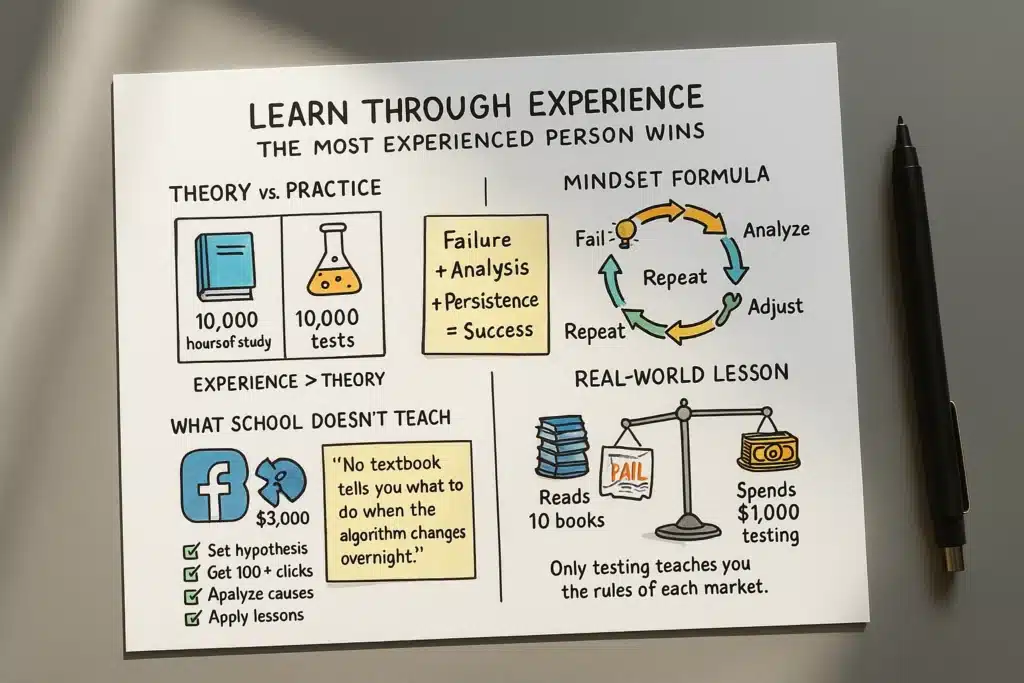
Learn Through Experience: The Most Experienced Person Wins
Affiliate marketing isn’t a field you can master through books or online courses. It’s an industry where you pay “tuition” with real money and real time.
Learning affiliate marketing isn’t like school.
In school, you have teachers, assignments, and a clear curriculum. In affiliate marketing, nobody tells you exactly what to do when a campaign fails or when the market suddenly changes.
I once lost $3,000 in a single day because Facebook changed its algorithm without warning. No textbook taught me how to handle that situation—I had to figure it out through trial and error.
The mindset needed: experiment—fail—analyze—adjust—repeat:
- Set clear hypotheses before testing
- Gather sufficient data before drawing conclusions (at least 100 clicks)
- Analyze failure causes objectively
- Apply lessons to the next test
Success formula: Failure + Analysis + Adjustment + Persistence = Success
“10,000 tests” are more effective than “10,000 hours of study”
I’ve met too many “affiliate experts” who can talk theory fluently but have never run an actual campaign. They know all about CTR, CPA, and EPC but freeze when faced with real-world problems.
Conversely, the most successful affiliates I know often aren’t great at explaining theory, but they have excellent intuition about what works—intuition honed through thousands of trials and errors.
A newcomer with $1,000 and a willingness to experiment will learn more than someone who reads 10 books about affiliate marketing without risking $1 on testing.
Real-world lessons from failure:
- Failed campaigns teach you more than successful ones
- Each vertical has its own unwritten rules that can only be learned through experience
- Markets constantly change; only continuous testing keeps you ahead

Master Audience Communication: Speak Their Language, Not Yours
One of the most important factors often overlooked in affiliate marketing is the ability to communicate effectively with your target audience.
Many marketers make the mistake of using generic language for all English-speaking markets. In reality, there are significant differences between:
- American English: Using terms like “apartment,” “elevator,” “vacation”
- British English: Using terms like “flat,” “lift,” “holiday”
- Australian English: Has many distinctive slang terms like “arvo” (afternoon), “brekkie” (breakfast)
I’ve seen conversion rates increase by 35% simply by switching landing page language from American English to British English when running campaigns in the UK.
Small changes like “fall” to “autumn,” “sweater” to “jumper” can make a significant difference in how authentic your offer appears.
Using target community slang
Each target group has its own vocabulary and jargon. Using these terms correctly not only helps you communicate effectively but also builds empathy and trust.
Examples:
- Fitness community: “gains,” “macros,” “PR” (personal record)
- Weight loss community: “NSV” (non-scale victory), “plateau,” “cheat day”
- Crypto investors: “DYOR” (do your own research), “diamond hands,” “HODL”
Key insight: Before writing ads for any market, spend time browsing forums, Facebook groups, and subreddits of that community to learn how they talk to each other.
I typically spend 3-4 hours studying community language before writing a single word of ad copy.
Simplifying your expression
One of the biggest mistakes I see affiliates make is writing too complexly, using long sentences and difficult vocabulary.
I use the Hemingway App to ensure my ad copy:
- Achieves a readability score of grade 6-10
- Limits passive sentences
- Uses short, clear sentences
- Avoids complex words when simple ones will do
Avoid long sentences and complex vocabulary.
Instead of writing: “This revolutionary product has been meticulously researched and developed by leading experts in the medical field with the purpose of minimizing uncomfortable symptoms related to chronic arthritis conditions.”
Write: “Top doctors created this product. It helps reduce pain from chronic arthritis.”
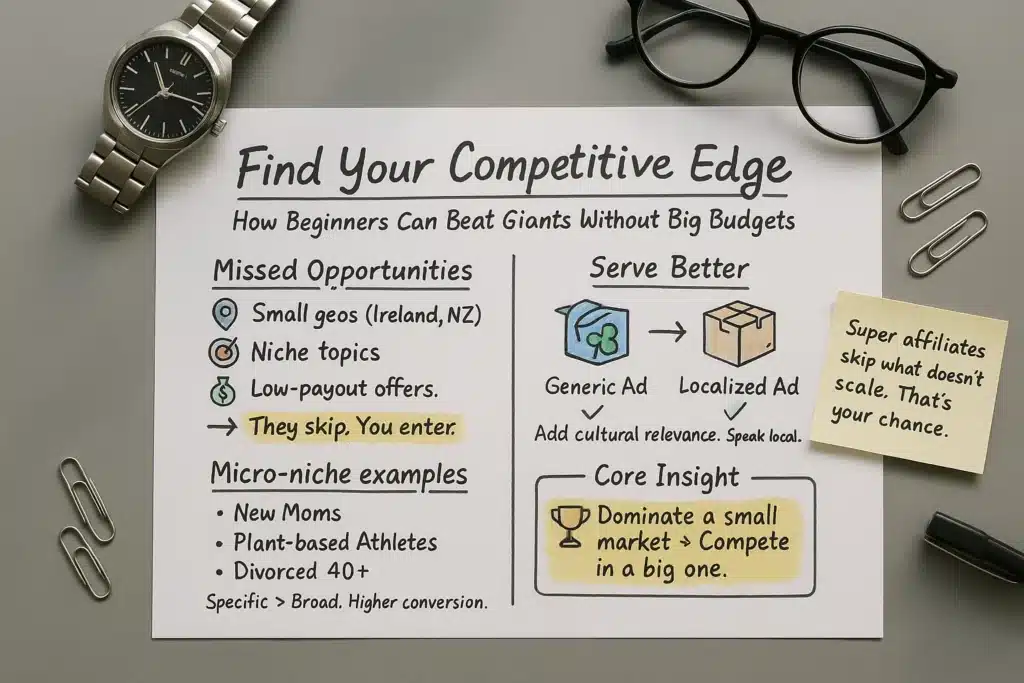
Find Your Competitive Edge: How Beginners Can Win Against Giants
If you’re new, don’t be discouraged when competing with super affiliates who have massive budgets. There are strategic ways you can still succeed.
Super affiliates typically seek large markets with scaling potential. They need campaigns that can spend $10,000+/day to meet revenue goals.
They want to go big, so they’ll skip “small” markets. They’ll overlook:
- Smaller geographic markets (like Ireland, New Zealand)
- Niche verticals (like specialized hobbies, specific health conditions)
- Low-payout offers (under $40-50)
This is precisely the opportunity for beginners.
One of my coaching clients focused solely on the Australian market for skin care products. He consistently earns $300-500/day without facing the fierce competition found in the US market.
Modeling campaigns and serving better
An effective strategy is to find successful campaigns from super affiliates and find ways to better serve that market. You can leverage their weaknesses such as:
- Lack of personalization: Super affiliates typically run large-scale ads; they can’t personalize for small segments
- Lack of deep optimization: They don’t have time to optimize details for every geo, device, and audience
Example: If you see a super affiliate running a weight loss campaign in Ireland with generic English landing pages…
…you could create a landing page with Irish cultural references, use images of local people, and mention local foods and eating habits.
Targeting micro-niches to increase conversion rates
Rather than targeting broad markets, narrow your audience to increase conversion rates.
Examples:
- Instead of “people wanting to lose weight,” target “new mothers wanting to lose post-pregnancy weight”
- Instead of “gym-goers,” target “plant-based athletes”
- Instead of “singles,” target “divorced professionals over 40 re-entering the dating scene”
To do this effectively, you need to know how to create compelling Marketing angles. I have a detailed article about angles that you can reference.
Key insight: The more specific you are, the higher your conversion rate. Don’t fear that a market is too small—better to dominate a small market than be unknown in a large one.
Conclusion – Timeless Principles in an Ever-Changing World
Affiliate marketing will continue to evolve over the next decade. New platforms will emerge, old ones will disappear. Algorithms will change, regulations will tighten.
But the fundamental principles I’ve shared will remain valid:
- Master market timing
- Choose the right offer
- Build sustainable competitive advantages
- Optimize for speed
- Learn through experience
- Communicate effectively with your audience
- Find your competitive edge in niche markets
These principles are your “north star,” helping you avoid the fundamental mistakes most beginners make. Not everyone succeeds by applying them—but those who succeed all follow these principles.
Don’t focus on what will change; focus on what won’t change in the next 10 years. In affiliate marketing, that’s precisely these 7 principles I’ve shared.
Which of these principles are you currently applying? And which ones are you struggling with? I’d love to hear your thoughts in the comments below.









